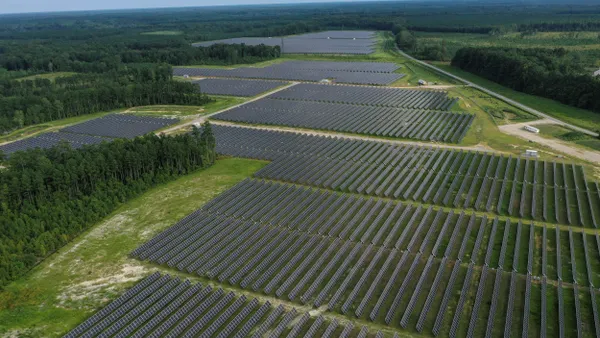Dive Brief:
- The United States "has the lowest renewable energy penetration among the top 5 global economies," Moody's Investors Service concluded in an infrastructure and project finance report released Monday. Leading that list is the European Union and U.K., followed by China, India and Japan.
- The analysis blames the laggard status on weak U.S. federal policies, including the lack of a national renewables mandate and inconsistent tax incentives for wind and solar. Where renewables have thrived in the United States, Moody's said, is in large part due to their growing cost competitiveness and local policy.
- Analysts and advocates agree U.S. federal policy has not sufficiently championed renewables growth, but see reasons for optimism with President Joe Biden indicating his support for clean energy. "It is really important for the federal government to lay down some markers and set some goals," said Uday Varadarajan, a principal in Rocky Mountain Institute's (RMI) carbon-free electricity practice.
Dive Insight:
Moody's report on international renewables development is blunt in its assessment of the United States' federal efforts.
"The United States' progress in renewables growth over the last decade has been the slowest among the five largest global economies, reflecting the lack of a US federal policy mandate on renewable energy and uncertainty created by intermittent federal tax subsidies," the report says.
Countries with the strongest renewables policies "have aggressive, long-term renewable energy objectives supported by economic incentives that encourage investment," Moody's analyst Clifford Kim said in a statement.
Looking at countries' renewables share of total generation in 2019, the United States achieved about 17% according to Moody's, while China is above 25% and the European Union and the United Kingdom pushed 35%.
The report notes that China and the European Union have both established policy goals on a national or economy-wide basis. The EU, for example, has a goal to have renewable power supply 32% of its energy needs by 2030. China wants non-fossil fuel power to provide half of its total electricity supply in that same timeframe, and according to Moody's, sets annual requirements for provincial renewable energy purchases.
Rather than renewables, the United States turned mostly to natural gas as it retired coal plants. The report says the U.S. "has been able to substantially reduce coal-fired generation's share of its power supply to 24% by 2019, from 45% in 2010." At the same time, natural gas-fired generation "has replaced most coal," rising from 24% in 2010 to 39% by 2019.
Despite weakness in federal policy, Moody's said a few leading states are helping advance renewables growth.
While federal policy has "historically been inconsistent and subject to short-term extensions, state-level support, especially in several leading states such as California and New York, has become more ambitious over time and influenced other states, given the size of their economies."
The growing cost competitiveness of renewable power, along with environmental, social and governance, and economic development considerations, "will further contribute to growth of renewables in the US," Moody's concluded. The firm also pointed to Biden taking office, noting "a significant increase in federal policy support for renewables has commenced."
Renewables advocates say the industry has made significant progress in recent years, in spite of the federal government.
"Despite the antagonism from the federal government, even the U.S. has had an unprecedented expansion of renewable energy in recent years," Nathanael Greene, senior renewable energy advocate at the Natural Resources Defense Council, said in an email.
"The economics of renewables are just that good, and utilities and regulators are seeing the benefit of investing in this technology," Greene said. "But given the urgency of the climate crisis, we need our new supportive federal administration to put its foot on the accelerator."
Renewables policy is already in a better place now than it was just a few months ago, said RMI's Varadarajan.
The investment tax credit and production tax credit were both extended in the second COVID-19 stimulus package, under President Donald Trump, and Biden has called for fleet electrification and a zero-carbon electricity system by 2035.
Varadarajan also said that under Biden, the Environmental Protection Agency will stop "rolling back" clean energy rules. A New York Times investigation in January concluded the Trump administration "rolled back more than 100 environmental rules," most of them through the EPA.
Looking ahead, Varadarajan said the United States should consider "some combination of mandates and incentives" to grow renewable energy. Those could be a national carbon tax, renewables mandates, and reforms to existing renewables tax incentives to allow more utilities to access them for a wider range of projects.
"I think there's a lot of room for innovation in reforming our tax incentives, to be more technology neutral," Varadarajan said.
Slow renewables growth "is a reflection of lack of strong federal policy," Al Armendariz, senior director of federal campaigns for Sierra Club's Beyond Coal Campaign, said in an email. Federal tax relief for wind and solar companies "has been short term and inconsistent, and it needs to be put on stable long-term footing in order for utilities and clean energy developers and their workers to have stability."
"In addition, the U.S. lacks a national clean energy standard," Armendariz said. "We need a national clean energy standard that phases out fossil fuel use by 2030," which he added would create millions of jobs.














